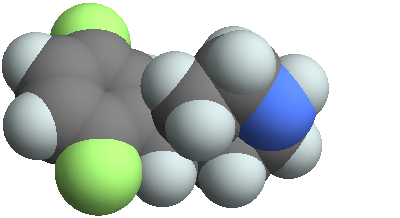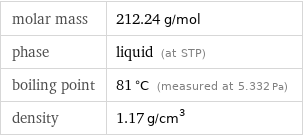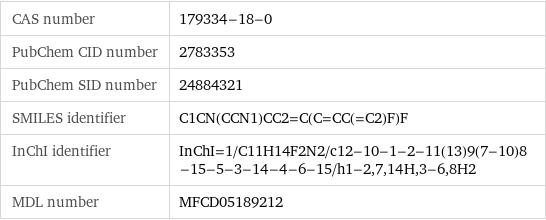Input interpretation

1-(2, 5-difluorobenzyl)piperazine
Chemical names and formulas
![formula | C_11H_14F_2N_2 name | 1-(2, 5-difluorobenzyl)piperazine IUPAC name | 1-[(2, 5-difluorophenyl)methyl]piperazine alternate names | 1-[(2, 5-difluorophenyl)methyl]piperazine mass fractions | C (carbon) 62.2% | F (fluorine) 17.9% | H (hydrogen) 6.65% | N (nitrogen) 13.2%](../image_source/217f3ab06760c26fa6977638fc798bd1.png)
formula | C_11H_14F_2N_2 name | 1-(2, 5-difluorobenzyl)piperazine IUPAC name | 1-[(2, 5-difluorophenyl)methyl]piperazine alternate names | 1-[(2, 5-difluorophenyl)methyl]piperazine mass fractions | C (carbon) 62.2% | F (fluorine) 17.9% | H (hydrogen) 6.65% | N (nitrogen) 13.2%
Lewis structure

Draw the Lewis structure of 1-(2, 5-difluorobenzyl)piperazine. Start by drawing the overall structure of the molecule, ignoring potential double and triple bonds: Count the total valence electrons of the carbon (n_C, val = 4), fluorine (n_F, val = 7), hydrogen (n_H, val = 1), and nitrogen (n_N, val = 5) atoms: 11 n_C, val + 2 n_F, val + 14 n_H, val + 2 n_N, val = 82 Calculate the number of electrons needed to completely fill the valence shells for carbon (n_C, full = 8), fluorine (n_F, full = 8), hydrogen (n_H, full = 2), and nitrogen (n_N, full = 8): 11 n_C, full + 2 n_F, full + 14 n_H, full + 2 n_N, full = 148 Subtracting these two numbers shows that 148 - 82 = 66 bonding electrons are needed. Each bond has two electrons, so in addition to the 30 bonds already present in the diagram add 3 bonds. To minimize formal charge carbon wants 4 bonds. Identify the atoms that want additional bonds and the number of electrons remaining on each atom: Fill in the 3 bonds by pairing electrons between adjacent highlighted atoms. Note that the six atom ring is aromatic, so that the single and double bonds may be rearranged: Answer: | |
3D structure

3D structure
Basic properties

molar mass | 212.24 g/mol phase | liquid (at STP) boiling point | 81 °C (measured at 5.332 Pa) density | 1.17 g/cm^3
Units

Liquid properties (at STP)

density | 1.17 g/cm^3 refractive index | 1.517
Units

Chemical identifiers

CAS number | 179334-18-0 PubChem CID number | 2783353 PubChem SID number | 24884321 SMILES identifier | C1CN(CCN1)CC2=C(C=CC(=C2)F)F InChI identifier | InChI=1/C11H14F2N2/c12-10-1-2-11(13)9(7-10)8-15-5-3-14-4-6-15/h1-2, 7, 14H, 3-6, 8H2 MDL number | MFCD05189212
Safety properties

flash point | 230 °C